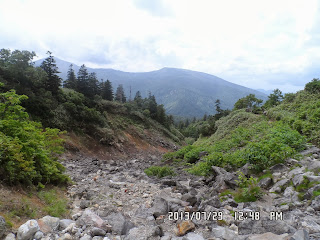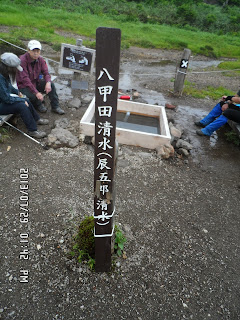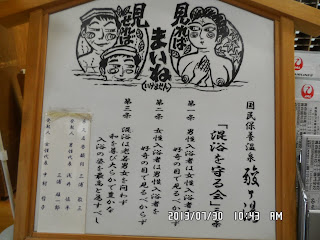Mountain: The Hakkōda Mountains, Mount Ōdake (1,584m)
Hiking Course: Sukayu (11:30) - Entrance of the trail to Mt. Ōdake (11:41) – Jigokuyu-no-sawa (12:51) – Shennintai (13:33) – Hakkoda-shimizu (13:42) – Kagaminuma (14:26) – Summit of Ōdake (14:38) – Fork Point of Akakura (14:50) – Mizubasho (15:16) – Kenashitaia – Sukayu (16:40)
Public Transportation from Ofuna: JR Ofuna – Tokyo - (Tohoku Shinkansen) – Aomori (JR Tohoku Bus) “Mizuumi” – Sukayu
Hotel: Sukayu Hotspring Inn (13,800 yen with 2 meals) http://www.sukayu.jp/index2.html
The Hakkōda Mountains (八甲田山系 Hakkōda-sankei) is a volcanic mountain range that lies to the south of Aomori city in Aomori Prefecture, Japan. The range consists of more than a dozen stratovolcanoes and lava domes arranged into two volcanic groups. The Northern Hakkōda Volcanic Group emerges from the rim of a 8-km wide caldera that dates back to the Pleistocene. The Southern Hakkōda Volcanic Group predates the caldera.
The highest peak in the range is Mount Ōdake, which can be climbed from Sukayu Onsen in about four hours. Heavy snowfall makes Hakkoda a prime destination for backcountry and mountain skiers, and there are two mountain huts for overnight trips. The lower slopes of the mountains are forested interspersed with moorland. Above 1300 meters, the Alpine climate zone starts.
The Hakkōda Mountains, along with Lake Towada and the Oirase Valley make up the Towada-Hachimantai National Park.
http://en.wikipedia.org/wiki/Hakk%C5%8Dda_Mountains
I climbed 6 mountains during my vacation in Japan this summer. The last mountain is The Hakkoda Mountains, Mount Ōdake (1,584m)
I took a train leaving Ofuna at 5:37, and changed to Tohoku Shinkansen "Hayabusa #1" at Tokyo. I arrived at Shin Aomori at 9:47.
I changed to JR Tohoku Bus “Mizuumi”, leaving Shin Aomori at 10:10 and arrived at Sukayu Hot Spring at 11:20.
After checking in, I began hiking to Mount Ōdake immediately. I followed the model course I found in the web (Wikipedia).
Before the hike, I dropped in the visitor’s center near the parking lot, and I began hiking at 11:41.
I headed for Sennintai Hights via Jigokuyunosawa. “Jigoku” means hell and “yu” means hot-spring.
The area produces toxic gas like Jigokudani in Hakone. So, there was no plant along the river.
When I went through the barren area, I came to a plat area with many vegetation and running cold walter area. It was the edge of Sennintai.
When I reached at Sennintai, there was thick mist in the wet land. I stopped at Sennintai Lodge for a short break.

[Gentiana thunbergii or "Harurindo" &"Drosera rotundifolia" (the common sundew or round-leaved sundew)、ハルリンドウと食虫植物『モウセンゴケ』、봄 용담과 식충 식물 "끈끈이 주걱" ]
They asked me where I was heading, so I responded that I was heading to the summit, they looked puzzled.
The cloud seemed coming down from the summit. So, I hurried to climb the mountain.
There was much snow on the slope. When I walked over the snow, then small black flies attached my feet, just like I experienced at Ozenuma a couple of years ago.
Maybe I need some protection against them. There was still some distance from the area. I hesitated where I should go or return, but I made my mind to go ahead in spite of the bad weather. I passed near Kagamisuma (crater pond) at 14:26 and passed the small shrine near the summit and arrived at the summit of Ōdake at 14:38.
There was nobody except me. I was completely in the cloud. So, I hurried to descend the mountain.
Before reaching to Kenasitai Plain, it began raining. I wore raincoat and put water-free cover to my bag and continued walking.
Then soon the rain stopped and I was in Kenashitai.
The flora in Kenashitai was different from those of Sennintai, so I was glad that I did not return to Sukayu using the same trail.
I was especially happy when I saw group of Lysichiton camtschatcensis(Asian skunk cabbage or white skunk cabbage).
These flowers are famous in Oze Wetland in June. Since Hakkoda is much north than Oze, and because of much snow remained, these flowers bloomed later than those in Oze.
Although it stopped rain, my short pants got wet because all grasses were wet in the wet land.
However, they got dry soon, so I did not feel bad at all.
The descending trail was a bit longer than ascending trail, but slope was gentle and there was no barran area such as Jigokuyunosawa.
I came down to Sukayu Hop Spring at 16:30. I was the last person to check in the hotel.
The clerk led me to my room upstairs. It was a traditional Japanese tatami room.
After a while, I went down to the famous 1000-person Hot Spring.
The entrances of the big bath room for men and for wemen were separated. But men and women shared the big bath room.
However there was a wooden screen which hid women from men. Women were free to come to the big bath tub.
When I entered the big bath tub, there was only one Western woman in the common bath tub.
It seemed that her husband was waiting for her in the big bath tub. They reminded me of Mr. & Mrs. Water who used to enjoy this kind of “mix bath” when they were in Japan several decades ago.
The dinner was delicious and plenty. I happened to talk with a male guest who came from Saitama. He said he was 64 and just retired recently. He said he liked traveling alone by car.
After having dinner, I noticed the Western couple who were taking bath at 1000-bath tub together. I spoke to them and found out that the lady was from England, and the man was from New Zealand. They were planning to go to Hokkaido by boat.
It seemed that they were the only foreigners at the inn that night.
-----------------------------------------------------------------------------------------------------------------------
分類:登山、日本、東北, 登山、日本百名山(100 Famous Japanese Mountains)
登山日:2013年7月29日(月)曇り、一時雨
登山目的地:青森県「八甲田山[八甲田大岳(1,552m)]」
コース及びコースタイム: 酸ヶ湯(11:30)~薬師神社(11:38)~大岳登山口(11:41)~地獄湯の沢(12:51)~仙人岱分岐点(13:29)~仙人岱ヒュッテ(13:33)~八甲田清水(13:42)~鏡沼(14:26)~大岳山頂(14:38)~大岳・赤倉分岐点(14:50)~水芭蕉群落地(15:16)~[毛無岱湿原]~酸ヶ湯温泉(16:40)[約10km弱、約5時間、標高差700m]
大船からの交通機関:[往路]JR大船 → 東京 (東北新幹線) → JR青森駅下車、JRバス東北「みずうみ号」→ 酸ヶ湯温泉下車
宿泊:「酸ヶ湯温泉旅館」イ棟2階、一泊二食13,800円(当日現地で申し込んだ。)
http://www.sukayu.jp/index2.html
八甲田山(はっこうださん)は、青森市の南側にそびえる複数火山の総称で日本百名山の一つ。「八甲田山」と名がついた単独峰は存在せず、18の成層火山や溶岩円頂丘で構成される本州最北の火山群。
命名の由来について「新撰陸奥国志」によれば、八の(たくさんの)甲(たて)状の峰と山上に多くの田代(湿原)があるからという。現在の火山活動は穏やか。周辺は世界でも有数の豪雪地帯。
明治35年に青森の歩兵第五連隊が雪中行軍の演習中に記録的な寒波に由来する吹雪に遭遇し、210名中199名が遭難した事件(八甲田雪中行軍遭難事件)が発生、それを基に新田次郎の小説「八甲田山死の彷徨」が書かれている。
以上、ウィキペディア
http://ja.wikipedia.org/wiki/%E5%85%AB%E7%94%B2%E7%94%B0%E5%B1%B1
夏休み帰国中の日本最期の登山は東北の八甲田山に決めた。この日、妻が朝4時半に目覚ましをかけて起きてくれた。
朝食を家で食べ、おにぎりやつまみも用意してもらった。プレミアムアサヒの缶ビールも2個、保冷バックに入った。
大船発5:37で東京乗り換え、新青森へ9:47着。新幹線の中はけっこう混んでいて、窓際の席はとれなかった。
東京から乗った客が仙台で下車しても次の客が座り、結局窓際はなし。
新青森では1日1本の10:10発十和田湖行きのバスに連結し、酢が湯には11:20着。
有名な千人風呂がある酸ヶ湯温泉旅館で聞くと空き室有。1泊2食で1万円強。チェックインだけ済ませて、不要な荷物は控室に置いて、山に向かった。
コースはウェブに記載されていたモデルコース:酸ヶ湯温泉バス停→地獄湯の沢→仙人岱→八甲田大岳→毛無岱→酸ヶ湯温泉バス停・所要時間5時間(標高差700m)。
登山前に情報センターものぞいてみたが地図などはなし。かまわず、標識に示される通り、酢が湯ホテル左横のトイレの脇の登山口から仙人岱を目指した。
地獄湯の沢までの登山道は両側から灌木が多い被り、足場が濡れて歩きにくい。1時間ほど登ると右手に沢の音が聞こえ、そのころ8人パーティとすれ違った。
植物が育たない不毛の地域を過ぎて、沢の両側に植物が生えそろう部分で最初の休憩をとり、握り飯を1個食べた。
ここを越すと木道が整備されている仙人岱だが、このころ霧が次第に濃くなり、天気が崩れそうになってきた。

[Gentiana thunbergii or "Harurindo" &"Drosera rotundifolia" (the common sundew or round-leaved sundew)、ハルリンドウと食虫植物『モウセンゴケ』、봄 용담과 식충 식물 "끈끈이 주걱" ]
その後分岐点まで戻って先に進むと「辰五郎」水飲み場に出た。ここには3人のハイカーが休憩中で、雲が低くなり、私が頂上を目指すと大変だろうなという顔をした。
水飲み場で冷たい水を飲んでから先へ進むと、残雪が大量に残る頂上直下の場所に出た。
雪渓をトラバース(13:50)して登ると沼があり、桜が咲いていた。
また、両足にブヨがとりつき、痛かゆいのは尾瀬沼と同じ体験だ。
次回、似た環境の場所へ行くときは虫除けスプレーなどが必要かもしれない。
雪原のトラバースから頂上まではかなりの距離があり、天候の悪化も相まってかなり躊躇した。
結局、噴火口跡の「鏡沼」を14:26に通過、頂上付近の神社を過ぎて大岳頂上には14:38に到着した。
このころはすっかり霧につつまれ、人影はなかった。三脚を持参しなかったので、杭などを利用してセルフタイマーを使った。
この後、毛無岱へ下る途中で雨が降り出した。かなり濡れてからミジョンにもらった上着を出して着て、リュックに防水カバーもかけた。
すると雨は小降りになり、木道に出るころは止んだ。
毛無岱の植物相は仙人岱のそれとはかなりちがっていて、それだけでも同じ道を引き返さなくてよかったと思った。
特に木道に出るとすぐにかわいい水芭蕉の群落をみたのはラッキーだった。
きっと雪がつい最近まで残っていて、水芭蕉の開花が遅れたのだろう。
雨は止んだが、足元の草木が濡れていて半ズボンがかなり濡れてしまったがこれは乾くのも早く、正解だった。
美貞からもらった上衣は水をよくはじいて、快適だった。
木道が濡れていて滑りやすいので気を付けた。こちらの下山コースは地獄湯の沢のような場所もなく、尾瀬のような湿地帯をなだらかに下るもので楽である。
湿原が終わってから酢が湯までの道も上りよりなだからで、時々上りもあるコースだが、標識によるとこちらの方が長い(5.2km)。
酢が湯へ下った時間は16:30で登山時間はちょうど5時間だった。
酢が湯ホテルのチェックインは私が最後で、宿の人が施設の案内をして部屋へ案内してくれた。
203号室は一人用の部屋のようで、隣が4人部屋だったようだ。
荷物を整理して、乾すものを乾してから、有名な千人風呂へ入った。
現在も混浴だが、女性は大部分、仕切りの向こう側で、大風呂へ来る人はほとんどいない。
ウォルター先生夫妻を思い出させるような西洋人のカップルが大風呂へ入ってきた唯一のカップル。
風呂から上がって5時半からの夕食はアユの塩焼きや豚肉の鍋焼きなど十分に豪華だった。
私は個客で4人用の囲炉裏に座ったが、隣の客と話をした。
彼は64歳で定年後初めての一人旅だと言う。埼玉の人で十和田湖を越えて車で来たと言う。
かなり楽しく会話を楽しみ、私はビールを2本空けた。食べ終わって、部屋へ戻る時、外国人カップルが食事をしていたので話しかけた。
女性はイギリス人で男性はニュージーランド人。これから青函連絡船(?)で北海道へ渡り旅をすると言う。この夜の外国人はこのカップルだけのようだった。



























































































































0 件のコメント:
コメントを投稿